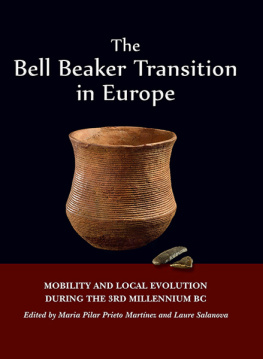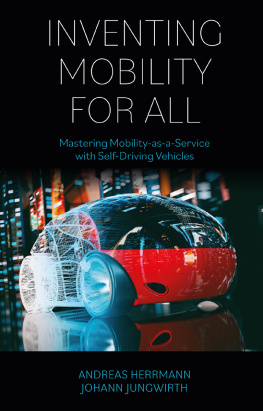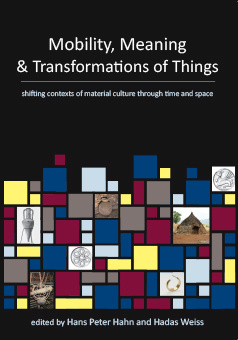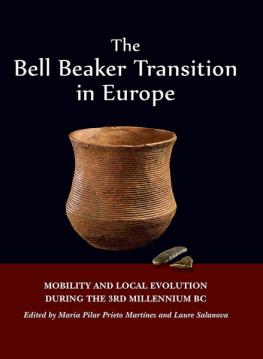Published in the United Kingdom in 2015 by
OXBOW BOOKS
10 Hythe Bridge Street, Oxford OX1 2EW
and in the United States by
OXBOW BOOKS
908 Darby Road, Havertown, PA 19083
Oxbow Books and the individual authors 2015
Hardcover Edition: ISBN 978-1-78297-927-2
Digital Edition: ISBN 978-1-78297-928-9
Kindle Edition: ISBN 978-1-78297-929-6
PDF Edition: ISBN 978-1-78297-930-2
A CIP record for this book is available from the British Library
The Bell beaker transition in Europe : mobility and local evolution during the 3rd millennium BC / edited by Maria Pilar Prieto Martnez
and Laure Salanova.
pages cm
Includes bibliographical references.
ISBN 978-1-78297-927-2 (hardcover) -- ISBN 978-1-78297-928-9 (digital) 1. Bell beaker culture. 2. Pottery, Prehistoric--Europe.
3. Excavations (Archaeology)--Europe. 4. Europe--Antiquities. 5. Human beings--Migrations. I. Prieto Martnez, M. Pilar, editor.
II . Salanova, Laure, editor.
GN778.2.B44B458 2015
936--dc23
2015020109
All rights reserved. No part of this book may be reproduced or transmitted in any form or by any means, electronic or mechanical including photocopying, recording or by any information storage and retrieval system, without permission from the publisher in writing.
Printed in Malta by Melita Press
For a complete list of Oxbow titles, please contact:
UNITED KINGDOM
Oxbow Books
Telephone (01865) 241249, Fax (01865) 794449
Email:
www.oxbowbooks.com
UNITED STATES OF AMERICA
Oxbow Books
Telephone (800) 791-9354, Fax (610) 853-9146
Email:
www.casemateacademic.com/oxbow
Oxbow Books is part of the Casemate Group
Front cover: All Over Cord Beaker from Bathgate, West Lothian, Scotland. Photo: National Museums Scotland
CONTENTS
Maria Pilar Prieto Martnez and Laure Salanova
Alexander Falileyev
Elbieta Haduch
Przemysaw Makarowicz
Jan Turek
Andrew P. Fitzpatrick
Johannes Mller, Martin Hinz and Markus Ullrich
Magnus Artursson
Christopher Prescott and Hkon Glrstad
Jessie Cauliez
Ewen Ihuel, Nicole Mallet, Jacques Pelegrin and Christian Verjux
Carlos Rodrguez-Relln, Antonio Morgado Rodrguez, Jos Antonio Lozano
Barbara Armbruster and Beatriz Comendador Rey
Manuela Costa-Casais, Lourdes Lpez-Merino, Joeri Kaal and Antonio Martnez Cortizas
Sebastin Prez Daz and Jos Antonio Lpez-Sez
Elisa Guerra Doce, Francisco Javier Abarquero Moras, Germn Delibes de Castro, ngel Luis Palomino Lzaro and Jess del Val Recio
Oreto Garca Puchol, Joan Bernabeu Aubn, Llus Molina Balaguer, Yolanda Carrin Marco and Guillem Prez Jord
Pablo Vzquez Liz, Laure Nonat and Maria Pilar Prieto Martnez
Maria Pilar Prieto Martnez and Laure Salanova
PREFACE
Maria Pilar Prieto Martnez and Laure Salanova
This volume brings together 17 carefully selected articles, written by 43 researchers, who presented an initial form of their projects during the 15th International Bell Beaker Conference From Atlantic to Ural, organised in May 2011 in Poio (Spain) by the University of Santiago Compostela and the French National Centre for Scientific Research (CNRS).
Could the circulation of objects or ideas and the mobility of artisans explain the unprecedented uniformity of the material culture observed throughout the whole of Europe? This was the basic theme of the 15th International Bell Beaker Conference, where 60 contributions were presented. The successful attendance and the quality of the projects that were presented during the conference suggested a publication. One volume was published in 2013, grouping together 20 papers that mainly concerned new excavations or item analyses (Prieto Martnez and Salanova 2013). The second volume presented here contains more synthetic overviews. The papers were selected for their major interest in the Bell Beaker phenomenon in Europe and for the different perspectives they offer. Indeed, Bell Beaker pottery is no longer the main protagonist of the current studies, which are henceforth focused on social groups (craft specialists, warriors, chiefs, extended or nuclear families), using technological studies and physical anthropology to understand the mobility patterns during the 3rd millennium BC. Chronological evolution is used to reconstruct the rhythm of the Bell Beaker diffusion and the environmental background that could explain this mobility and the socioeconomic changes observed during this period of transition toward Bronze Age societies.
The chapters are mainly organised geographically, as the archaeological data and the research traditions are different according to European countries. We begin with eastern Europe and continue through to the Mediterranean shores and finish with the Atlantic coast of the Iberian Peninsula. This volume includes some of the areas that are traditionally studied and well known, such as France, the British Isles or central Europe, and also includes areas that have so far been considered peripheral, such as Norway, Denmark or Galicia, which are usually absent from summaries on Bell Beakers. This journey not only offers a complex and diverse image of Bell Beaker societies but also of a supraregional structure that articulated a new type of society on an unprecedented scale.
In the first chapter, A. Falileyev discusses the Bell Beaker relationship with Indo-European linguistics. Using different theories, he presents the problems that arise when associating speakers of Indo-European and Celtic languages with archaeological remains. He highlights the fact that the latest research points towards the coherence of the existence of multilingualism (using both Indo-European and non-Indo-European languages) amongst the Beaker Folk. However, this recent research poses more questions than it answers, together with the need to continue comparing archaeology and linguistics. If this dimension is not easily elucidated, how to reach the other dimensions of the Bell Beaker phenomenon?
In her anthropological study, E. Haduch demonstrates that the Bell Beaker populations from the Little Poland Upland show uniformity in their morphological features and proportions, which are clearer in the male population than the female one. Their anthropological characteristics obviously differ from the local Corded Ware Culture populations and the Early Bronze Age group of the Mierzanowice culture, leading to the conclusion that Bell Beaker groups are allochthonous. This work confirms the results obtained in other regions of eastern and central Europe, where the appearance of Bell Beakers seems to be clearly linked with the arrival of foreign groups (Price et al. 1988; Desideri 2011). Why did these groups move during the 3rd millennium BC? Who were they?
Based on a study of grave goods and the spatial organisation of cemeteries between the Oder and Vistula rivers, P. Makarowicz highlights social and gender structures of adult burials. The number of graves in each cemetery (1015), organised in rows, could suggest nuclear families. Nevertheless, the composition of the grave good assemblages in each grave reveals some differences that go beyond age or gender, demonstrating an inequality that was institutionalised in a hierarchy of positions based on prestige and dominance, a typical feature of a chiefdombased society.
In his technological approach to the wrist-guards found in the individual graves from central Europe, J. Turek proposes the same differences, even among the archer graves, as some raw materials are more frequently associated with the richest burials. In contrast to some pieces from western Europe (Salanova and Sohn 2007), the wrist-guards from central Europe never present use-wear, suggesting a symbolic role of these objects as an adornment and also a ceremonial significance in relation to warfare and Bell Beaker ideology.
Next page








